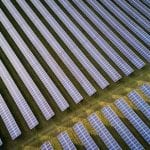Around The Web
'Super-sized' mice threaten seabird colonies with extinction
Redflow Board gains manufacturing expertise
 Australian energy storage company Redflow Limited has today strengthened its Board by recruiting David Brant, an experienced businessman with strategic manufacturing expertise.
Australian energy storage company Redflow Limited has today strengthened its Board by recruiting David Brant, an experienced businessman with strategic manufacturing expertise.
The post Redflow Board gains manufacturing expertise appeared first on RenewEconomy.
FareShare's surplus food redistribution saves UK £51m a year
Charities tackling hunger could save Britain £500m a year if they had capacity, finds report
The collection and redistribution of edible food by the UK’s largest charity tackling hunger – and that would otherwise go to waste – saves the UK economy some £51m every year, according to an independent report published on Monday.
If FareShare and other charities in the sector were able to scale up their capacity in order to handle half of the surplus food available in the UK supply chain, the value back to the state could be as much as £500m per year, it claims.
Continue reading...Plastic straws and cotton buds could be banned within a year
Michael Gove unveils consultation on move to cut pollution and protect oceans
Plastic straws, drink stirrers and cotton buds could be banned within a year under government plans to cut pollution, Michael Gove is to announce.
Launching a consultation on the proposals on Monday, the environment secretary will cite the success of the 5p charge on single-use plastic bags, which led to an 86% drop in their use at major supermarkets.
Continue reading...Solar sends day-time prices negative in coal-dominated Queensland
 Solar pushes wholesale prices into negative territory on two consecutive days in Queensland, highlighting changing shape of the grid.
Solar pushes wholesale prices into negative territory on two consecutive days in Queensland, highlighting changing shape of the grid.
The post Solar sends day-time prices negative in coal-dominated Queensland appeared first on RenewEconomy.
Australia large scale solar output breaks through 1GW on Sunday
 Combined output of Australia's large scale solar farms breaks through 1GW mark for first time.
Combined output of Australia's large scale solar farms breaks through 1GW mark for first time.
The post Australia large scale solar output breaks through 1GW on Sunday appeared first on RenewEconomy.
Climate change: Nauru's life on the frontlines
Look after the soil, save the Earth: farming in Australia's unrelenting climate
Former governor general Michael Jeffery says soil health and regenerative farming is essential for security and carbon emissions
From the red soil of his hometown in the Western Australian outback town of Wiluna, Michael Jeffery very nearly became a farmer.
He opted for being a soldier instead, serving in Malaya, Borneo and Vietnam, where he was awarded the Military Cross and the South Vietnamese Cross of Gallantry. After a distinguished military career, he served as governor of his home state of Western Australia and governor general of Australia – who represents the Queen, Australia’s head of state.
Continue reading...Washing up yourself is good for the soul | Letters
I have to take issue with Jo Steranka (How you can do your bit in the war against climate change, Letters, 18 October). Dishwashers are typically much more efficient than hand washing in terms of energy and water consumption. Research carried out by Christian Paul Richter (Usage of dishwashers: observation of consumer habits in the domestic environment, International Journal of Consumer Studies, 2011) on 200 households in Germany, Italy, Sweden and Britain, found that households with a dishwasher used on average 50% less water and 28% less energy per cleaned item than households that didn’t own a dishwasher. Even so, a higher degree of sustainability was identified because 20% of dishwasher cycles were not fully utilised and 52% operated at a temperature that was higher than necessary.
Furthermore, Jo Steranka states that “opinion pieces don’t help if they don’t offer practical solutions”; er, has she tried digging up a paved garden? Getting around a city (that isn’t London) without a car? Not buying new clothes until the old ones wear out? Get real, Jo! (Although I do agree about buying local produce and turning off the lights at bedtime – are there people who don’t?)
Continue reading...Bottle it up: the car park that lets drivers pay in plastic
A scheme at one Leeds’ CitiPark hopes to encourage recycling by giving motorists a 20p parking voucher for every bottle they bring in
It seems a great idea: take plastic bottles along to a car park to recycle, help rid the world of plastic pollution and get money off the cost of parking. This is the scheme running at the Leeds Merrion Centre CitiPark. For a month-long trial period, the company will collect every plastic bottle of at least 500ml brought into the car park. The bottle will be recycled and the motorist will get a 20p car parking voucher for each one. The process itself is quite straightforward: hand them to the attendant for a discount before paying. But will it catch on?
“It’s been going really well,” says parking attendant Richard Bedford. “One chap came in with 30 bottles. He only needed 15 to pay for his parking, so he’s bringing the rest back next week.” Apart from such isolated success stories, though, the car park isn’t exactly besieged by bottle-laden motorists when I arrive. Bedford estimates an average day’s take at 10 to 20 bottles, but behind him is a full crate, and he says hundreds have been recycled so far.
Continue reading...Legendary team's 1921 Everest album
'Headless chicken sea monster' filmed swimming off East Antarctica
'Headless chicken monster': deep-sea cucumber seen in Southern Ocean for first time
Creature filmed off east Antartica using technology developed by Australian researchers
A deep-sea cucumber known as a “headless chicken monster” has been filmed in the Southern Ocean for the first time using camera technology developed by Australian researchers.
The creature was filmed off east Antarctica and it is the first time the species has been seen in the area.
Continue reading...Minister’s claim badger cull cuts cattle TB is attacked by experts
Government claims that the controversial badger cull is reducing tuberculosis rates in cattle have been undermined by a group of leading vets and animal welfare experts who have shared data that, they say, confirms it has made no difference.
Last month the farming minister George Eustice said: “Reductions in TB cases in Somerset and Gloucestershire are evidence that our strategy is delivering results.” But the group, which includes Iain McGill, the former government vet who helped expose the BSE cover-up, Adam Grogan, head of wildlife at the RSPCA, and Mark Jones, head of policy at the Born Free Foundation, disagrees.
Continue reading...Wentworth wipe-out won’t shift Coalition on climate and energy
 For the second time in two months, a long-held conservative seat is lost to an independent campaigning on climate and energy. But don't expect the idiocy of the Coalition to stop.
For the second time in two months, a long-held conservative seat is lost to an independent campaigning on climate and energy. But don't expect the idiocy of the Coalition to stop.
The post Wentworth wipe-out won’t shift Coalition on climate and energy appeared first on RenewEconomy.
Tasmanian salmon should be off the menu for now, says conservation group
Fish eaters advised to ‘Say No’ due to environmental concerns surrounding Tasmania’s salmon farming industry
It’s one of Australia’s – and the world’s – favourite fish but Tasmanian Atlantic salmon should be off the menu for now, according to the Australian Marine Conservation Society, publishers of Australia’s independent sustainable seafood guide.
On Wednesday, the AMCS downgraded the farmed fish’s rating from an amber “Think Twice” to a red “Say No” due to ongoing environmental concerns. The previous review was in 2015.
Continue reading...Australia's native rhododendrons hide in the high mountain forests
Brazil museum fire: Prized 'Luzia' fossil skull recovered
Minor earthquakes detected near fracking site in Lancashire
One tremor was magnitude 0.3, the level beyond which experts say fracking has to proceed with caution
A series of small earthquakes have been detected in Lancashire close to the site where major fracking operations began this week.
The British Geological Survey, which provides impartial advice on environmental processes, recorded four tremors in the vicinity of the energy firm Cuadrilla’s site on Preston New Road near Blackpool on Friday.
Continue reading...‘We'll have space bots with lasers, killing plants’: the rise of the robot farmer
Tiny automated machines could soon take care of the entire growing process. Fewer chemicals, more efficient – where’s the downside?
In a quiet corner of rural Hampshire, a robot called Rachel is pootling around an overgrown field. With bright orange casing and a smartphone clipped to her back end, she looks like a cross between an expensive toy and the kind of rover used on space missions. Up close, she has four USB ports, a disc-like GPS receiver, and the nuts and bolts of a system called Lidar, which enables her to orient herself using laser beams. She cost around £2,000 to make.
Every three seconds, Rachel takes a closeup photograph of the plants and soil around her, which will build into a forensic map of the field and the wider farm beyond. After 20 minutes or so of this, she is momentarily disturbed by two of the farm’s dogs, unsure what to make of her.
Continue reading...


